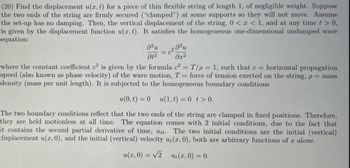
Advanced Engineering Mathematics
10th Edition
ISBN: 9780470458365
Author: Erwin Kreyszig
Publisher: Wiley, John & Sons, Incorporated
expand_more
expand_more
format_list_bulleted
Question
Hi, I posted this previously but the work wasn’t properly attached. If you could help me out I would appreciate it! :)

Transcribed Image Text:(20) Find the displacement u(x, t) for a piece of thin flexible string of length 1, of negligible weight. Suppose
the two ends of the string are firmly secured ("clamped") at some supports so they will not move. Assume
the set-up has no damping. Then, the vertical displacement of the string, 0 < x < 1, and at any time t > 0,
is given by the displacement function u(x, t). It satisfies the homogeneous one-dimensional undamped wave
equation:
მ2
მე2
where the constant coefficient c² is given by the formula c² = T/p=1, such that c = horizontal propagation
speed (also known as phase velocity) of the wave motion, T = force of tension exerted on the string, p = mass
density (mass per unit length). It is subjected to the homogeneous boundary conditions
u(0,t) = 0
u(1,t) = 0 t> 0.
The two boundary conditions reflect that the two ends of the string are clamped in fixed positions. Therefore,
they are held motionless at all time. The equation comes with 2 initial conditions, due to the fact that
it contains the second partial derivative of time, utt. The two initial conditions are the initial (vertical)
displacement u(x, 0), and the initial (vertical) velocity u(x, 0), both are arbitrary functions of x alone.
u(x, 0) = √2
u₁(x, 0) = 0.
Expert Solution
This question has been solved!
Explore an expertly crafted, step-by-step solution for a thorough understanding of key concepts.
Step by stepSolved in 2 steps with 8 images

Knowledge Booster
Similar questions
- Hello! I was able to get the first two parts then had to move away from the computer and was totally confused as to where I was left off at. Here's is the image it's asking to find margin of error.arrow_forwardPlease answer to the best of your abilityarrow_forwardplease answer the question in the attached picture with work shown, thanks! #10 and 11arrow_forward
- Given the following question complete the integral and give the solution. Problem 1. Evaluate , 32.ry'drdy. a. 480 O b. -450 Oc. -500 Od. -580 Nexarrow_forwardplease quickly thanks !!!arrow_forwardEualoate the functien hCx)= xY +Sx²+3 at the given and Simplify Values of the Independent variable h(3a)arrow_forward
- For part a and b, explain what is wrong with the statement. Зx +1 a. 2x dx = §*+* + C %3D 2. n+1 b. For all n, S x" dx = + C %3D n+1arrow_forwardCan I use another question to have the part(d) answered?arrow_forwardcan you please do both even though i know it’s only 1. Really need a good grade on thisarrow_forward
arrow_back_ios
SEE MORE QUESTIONS
arrow_forward_ios
Recommended textbooks for you
 Advanced Engineering MathematicsAdvanced MathISBN:9780470458365Author:Erwin KreyszigPublisher:Wiley, John & Sons, Incorporated
Advanced Engineering MathematicsAdvanced MathISBN:9780470458365Author:Erwin KreyszigPublisher:Wiley, John & Sons, Incorporated Numerical Methods for EngineersAdvanced MathISBN:9780073397924Author:Steven C. Chapra Dr., Raymond P. CanalePublisher:McGraw-Hill Education
Numerical Methods for EngineersAdvanced MathISBN:9780073397924Author:Steven C. Chapra Dr., Raymond P. CanalePublisher:McGraw-Hill Education Introductory Mathematics for Engineering Applicat...Advanced MathISBN:9781118141809Author:Nathan KlingbeilPublisher:WILEY
Introductory Mathematics for Engineering Applicat...Advanced MathISBN:9781118141809Author:Nathan KlingbeilPublisher:WILEY Mathematics For Machine TechnologyAdvanced MathISBN:9781337798310Author:Peterson, John.Publisher:Cengage Learning,
Mathematics For Machine TechnologyAdvanced MathISBN:9781337798310Author:Peterson, John.Publisher:Cengage Learning,


Advanced Engineering Mathematics
Advanced Math
ISBN:9780470458365
Author:Erwin Kreyszig
Publisher:Wiley, John & Sons, Incorporated

Numerical Methods for Engineers
Advanced Math
ISBN:9780073397924
Author:Steven C. Chapra Dr., Raymond P. Canale
Publisher:McGraw-Hill Education

Introductory Mathematics for Engineering Applicat...
Advanced Math
ISBN:9781118141809
Author:Nathan Klingbeil
Publisher:WILEY

Mathematics For Machine Technology
Advanced Math
ISBN:9781337798310
Author:Peterson, John.
Publisher:Cengage Learning,

